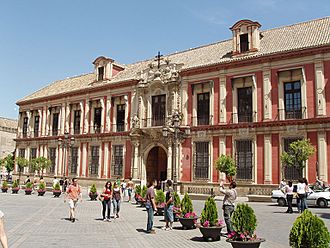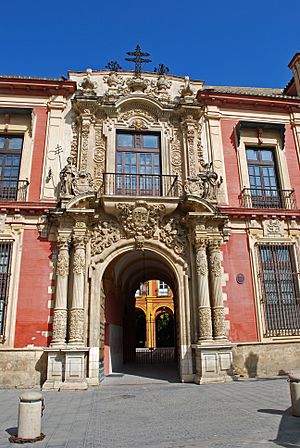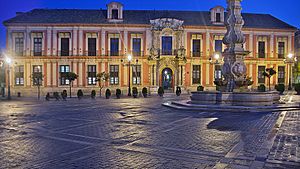Archbishop's Palace, Seville facts for kids
Quick facts for kids Archbishop's Palace |
|
|---|---|
 |
|
| General information | |
| Architectural style | Spanish Baroque |
| Location | Seville, Spain |
The Archbishop's Palace of Seville (also known as Palacio Arzobispal) is a beautiful old building in Seville, Spain. For a long time, it has been the home of important church leaders like bishops and archbishops. It has also housed many noble people and military leaders.
You can find this palace in the southern part of Seville, in a square called Plaza Virgen de los Reyes. It is almost directly across from the famous Giralda tower. The palace is on the northeast side of Seville Cathedral in the Santa Cruz neighborhood. It is built in the Spanish Baroque style, which is a fancy and decorative way of building. Since 1969, it has been recognized as a National Monument.
Contents
History of the Palace
The story of the Archbishop's Palace began a very long time ago. Records from January 4, 1280, show that in 1251, a king named Ferdinand III of Castile gave some walled houses to the Bishop of Segovia, Remondo de Losana. This happened after Seville was taken back by the Christians. The king wanted to create a new home for the archbishop.
Remondo was the first bishop of Seville after this event. He was also the first to live in the new palace. Over many centuries, the palace grew bigger and bigger. By the mid-1500s, it had two courtyards and covered a huge area of about 6,700 square meters. That's almost an entire city block!
During a short war called the Peninsular War, the palace was used for a different purpose. It became the main office for the army's general command. A French marshal named Jean de Dieu Soult and his officers lived there. While Soult was staying there, many paintings and sculptures were brought into the palace. These included artworks like "The Beheading of St. John the Baptist" and "The Resurrection of Lazarus."
Palace Architecture
The Archbishop's Palace has many interesting architectural features, both inside and out.
Inside the Palace
A big expansion of the palace happened in 1704. This work was led by Lorenzo Fernandez de Iglesias, a well-known architect, and supported by Archbishop Manuel Arias. This project brought together different building styles. The walls were decorated with tall, flat columns called pilasters.
The Main Hall, also called the Salon, has paintings by Antonio Mohedano. It features four columns and two statues of saints. Mohedano was famous for painting natural things like birds, flowers, and fruits. He also painted the decorative ceiling in the Main Salon and the Prelate Gallery. Besides the painted ceiling, there are 70 paintings that celebrate the Catholic Church. You can also see a mural of five Apostles painted by Juan de Zamora.
The grand staircase was built in the second half of the 1600s. It was designed by Fray Miguel de Ramos and paid for by Juan de Palafox. This staircase is made of colorful marble. It is also decorated with murals that are thought to be painted by Juan de Espinal.
Outside the Palace
The outside of the palace is red with white pilasters. It has small iron awnings and large balconies. There are two courtyards built in the Mannerist style, which was popular between the 1600s and 1700s. The second courtyard has a fountain from the 1500s. Long ago, a duke even gave a lion cub to an archbishop, and it lived in this courtyard!
The palace has two main entry doors, one facing east and one facing south. The main entrance is decorated with plant designs and shields. It is topped with vases and bronze flowers. This main entrance was designed by Lorenzo Fernández de Figueroa and Diego Antonio Díaz. It was built in the 1700s in the Spanish Baroque style. It is a great example of Seville's Baroque architecture. The main door has columns that match the width of the patio. There are also several arches supported by small marble columns. A decorative ledge supports two statues.
Palace Collections
The palace has a very large library. It contains many important books, especially about church history and religious topics. The Archbishop's office, located within the library, holds old documents about the archdiocese of Seville. Some of these documents date back to the 1300s!
The palace also has a very important art collection. It includes paintings and sculptures from the Seville Baroque period. This art collection is so big that it is only smaller than the collections at the Museum of Fine Arts and Seville Cathedral. This makes the palace the third largest art gallery in the city.
The palace contains artworks by famous painters such as Francisco Herrera el Viejo, Francisco Pacheco, Zurbarán, Murillo, Antonio Palomino, and Juan de Espinal. There are also art collections from Italian and Dutch Baroque artists.
See also
 In Spanish: Palacio arzobispal de Sevilla para niños
In Spanish: Palacio arzobispal de Sevilla para niños
- List of Baroque residences
Images for kids





